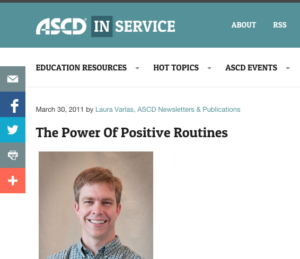The Power of Positive Routines
Original Article: http://inservice.ascd.org/the-power-of-positive-routines/
 Think about the amount of time that you spend on autopilot each day. Do you drive to work along the same route? Do you tend to park in the same spot when you get there? Once you enter the building, I bet you follow a predictable path. You might hang up your coat, put your lunch in the fridge, turn on your computer, and start to check e-mail. Most of this time, you’re probably not even thinking about what you’re doing. You’re simply following your daily routines.
Think about the amount of time that you spend on autopilot each day. Do you drive to work along the same route? Do you tend to park in the same spot when you get there? Once you enter the building, I bet you follow a predictable path. You might hang up your coat, put your lunch in the fridge, turn on your computer, and start to check e-mail. Most of this time, you’re probably not even thinking about what you’re doing. You’re simply following your daily routines.
I think this is a good thing. As long as our routines are healthy and productive, they can be a great asset. Having predictable rhythms and routines allows us to focus our energy on the harder and more complex tasks of the day.
Our students also develop routines, which can either help or hinder their learning. I recently visited a couple of 5th grade classes. I watched a group of students enter one room for science class. They came into the room quietly and immediately sat down at their seats. They took out their science books and journals, made sure they had pencils, and started chatting pleasantly with their classmates as the teacher got ready for her lesson. Forty-five minutes later, I saw this same class head into a different room for their math lesson. They burst through the door, pushing, shoving, and talking loudly. They dropped books on the floor, wandered the room, and had to be reminded multiple times to get out their math materials. In each room, these students had a routine that they followed. And in each room, this was a direct result of the time the teacher had taken to directly teach students expected behaviors and then follow through to enforce those expectations.
One of the most important things we can do for our students is help them establish positive routines so that their “autopilot” is respectful of themselves and others, allows them to feel safe and supported, and helps them be ready for learning throughout the day. In my article in the April 2011 edition of Educational Leadership, “The Leap into 4th Grade,” I describe a process for teaching routines to students called interactive modeling.
What routines do you teach to your students? How do you help students set positive and productive rhythms and routines in your classroom?




